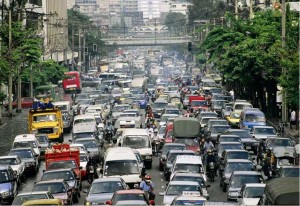
MANILA, Aug. 28 (PNA) — Before presenting to the Metro Manila Development Authority (MMDA) for approval, the Department of Transportation and Communications (DOTC) is first set to test its proposed traffic management plan for the Light Rail Transit Line 2 (LRT-2) Masinag Extension project on Saturday.
In a press conference on Friday, DOTC spokesperson Miguel Arthur Sagcal pointed out that while construction of the Masinag Extension might still generate traffic, commuters will eventually experience a bigger relief once the project is completed.
“We prepared a traffic management plan for what will be the effect of heavy traffic in the next two years while the (Masinag Extension) project is undergoing construction,“ Sagcal said in Filipino.
“However, we want to emphasize that the project itself is a solution to the heavy traffic we are currently experiencing,” he added.
The LRT-2 Masinag Extension project, which kicked off last June, involves the construction of a four-kilometer elevated viaduct from Santolan, Pasig City to Masinag, Antipolo City.
Under the project, two additional stations will also be built — the Emerald Station in Cainta, Rizal, and the Masinag Station at the Masinag Junction in Antipolo City.
DOTC said that the project is expected to be completed in the third quarter of 2017.
When completed, DOTC said that travel time from Masinag to Recto will be cut to 36 minutes, from conditions which require taking a jeep or UV Express ride, and a transfer to the LRT-2 Santolan Station to reach Recto, the total travel time of which usually takes over an hour to 1.5 hours.
D.M. Consunji, Inc. consultant Georgette Aquino said that construction of the project is expected to start on Sept 17 this year and be completed on Sept 26, 2016.
Construction works will begin near the Sta. Lucia East Grand Mall, and will be executed by two teams working in opposite directions towards the Masinag Junction and the Santolan Station, respectively.
DMCI has already begun initial test pitting, spanning a 300-meter section along the center island of Marcos Highway.
Once construction is in full swing, the entire 3.9-kilometer stretch will have reduced lanes for traffic: the current five lanes per direction will be down to four lanes each, as the innermost lanes of both directions will be closed down.
Traffic management plan
DMCI said that under the traffic management plan, sections of the outermost lanes of each side will be used for loading and unloading bays for public utility vehicles (PUVs) while the remaining three lanes will be used for regular traffic, with the innermost open lane for U-turning vehicles, and the next lane for fast vehicles.
Three intersections along Marcos Highway will be opened for motorists: Felix Avenue Extension, Amang Rodriguez Intersection, and De La Paz Intersection.
For each U-turn slot that is closed for construction works, another U-turn slot will be opened nearby, to ensure that traffic flow is not disrupted.
Six alternate routes have also been identified, in order to give motorists other options: Sumulong Highway, A. Rodriguez to J. Rizal, Felix Avenue to Fernando Avenue, Calle Industria, Kaginhawaan, and Ortigas Avenue Extension.
Marcos Highway accommodates a volume of 5,172 vehicles per hour on the westbound lane and 705 vehicles per hour on the eastbound lane during morning peak hours.
For the evening peak, there are around 4,219 vehicles per hour on the westbound lane and 3,157 vehicles per hour on the eastbound lane.
The traffic management plan will kick off on Saturday (Aug 29) at 4 a.m.
Light Rail Transit Authority (LRTA) spokesperson Hernando Cabrera said that if traffic worsens after the traffic management plan is tested, agencies involved will consider doing back to the drawing board.
Joint effort
Land Transportation Office (LTO) spokesperson Jason Salvador said that the LTO will be deploying personnel to help enforce road discipline, such as proper loading and unloading at designated stops only, during construction.
“We will deploy our people there especially during rush hours in the morning and at night and if necessary during the weekends,” Salvador said.
Traffic signs will also be put up and 132 flag men will be deployed to guide motorists.
Movable waiting sheds which may be transferred as construction progresses will also be provided for commuters at designated loading and unloading areas.
Meanwhile, Sagcal said that if traffic management plan is successful, it will eventually be used for the Amang Rodriguez and De La Paz intersections.
He also assured that adjustments will be made as necessary, depending on its effect on traffic.
DOTC Undersecretary Edwin Lopez for his part urged the public—particularly motorists—to cooperate in the government’s efforts to improve the country’s transport industry.
“You can have the best plans in the world but if our motorists don’t cooperate, it won’t be successful,” Lopez said. “Traffic will only be solved if we all cooperate.” (PNA)
RMA/ANP